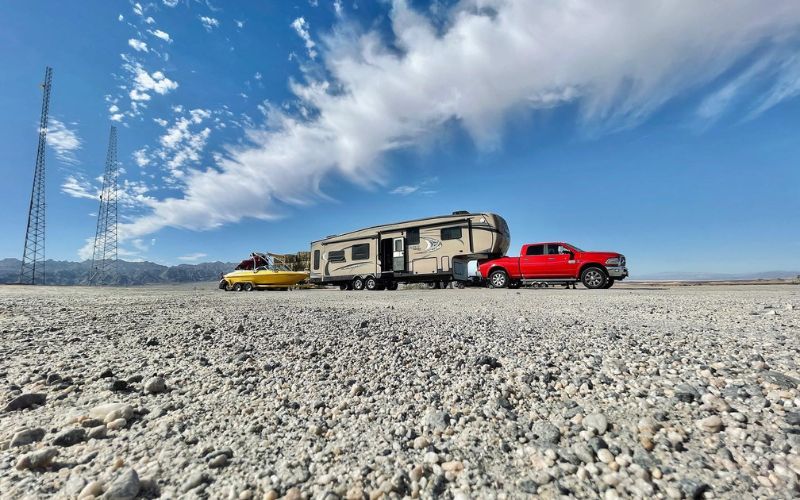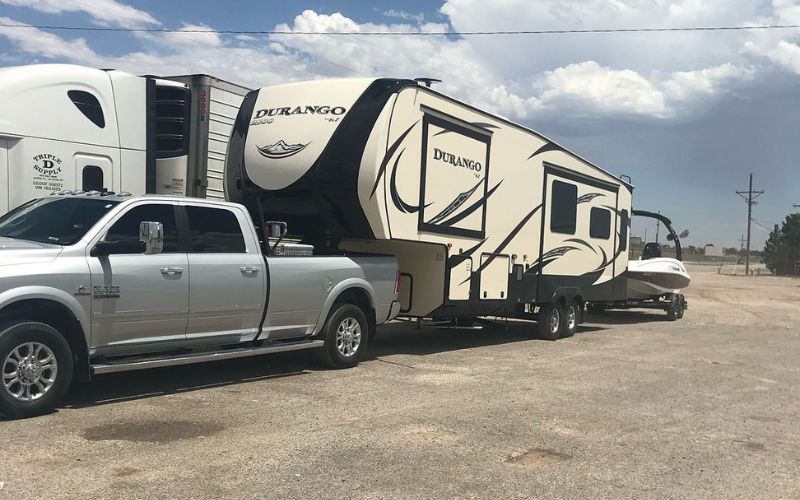A lot of the powerful trucks needed to pull a fifth-wheel trailer still have enough power in reserve to handle the rigors of double towing.
This involves adding an extra hitch to the back of your fifth-wheel trailer, which allows you to tow another trailer with you.
Though double towing a fifth-wheel isn’t allowed in every state, doing it safely means getting a lot of details right.
Not only are there a lot of technical specs that need to be correctly set up, but a lot of states also have regulations about hauling an extra trailer, boat, or car behind your trailer as well as how long of a total rig you can tow before you need a special driver’s license endorsement.
Known to some as “Triple Towing,” it is the sort of thing where you need everything to go right to pull it off perfectly, but it only takes one thing going wrong to turn it into a catastrophe.
You can use the following information to determine the regulations for your state, as well as how to double-tow your fifth wheel as safely as possible.
Is Double Towing A Fifth-Wheel Legal?
Some states do not allow double or triple towing of any kind on their roads. This includes:
Alabama, Delaware, Florida, Georgia, Illinois, Kansas, Louisiana, Maine, Maryland, Massachusetts, Michigan, Minnesota, Mississippi, Nevada, New Hampshire, New Jersey, New York, Oklahoma, Oregon, Rhode Island, Texas, Virginia, Washington State, West Virginia, Wisconsin, Wyoming
It’s also worth bearing in mind that certain states will require you to have a commercial driver’s license (CDL) or a special license endorsement based on the total length of your rig.
This means that a state like California, where you are allowed to double tow a fifth-wheel, will likely require you to have a CDL or a special license endorsement if the total combined length of your entire rig is greater than 45 feet.
Reasons Why You Might Want To Double Tow A Fifth-Wheel Trailer
There are certain travel styles where double or triple towing a fifth-wheel trailer is exceedingly tempting. This includes things like:
Taking Your Toys Along On Vacation
If you only have one tow vehicle in your family, and you want to bring your boat, golf cart, or ATV trailer with you, double towing starts to make a lot of sense.
Tradesmen Who Need Living Accommodations & Equipment
A lot of tradesmen choose to have their own RV or fifth-wheel trailer near a remote job site.
This is usually better accommodation than you can get with your per diem at a rundown hotel.
Though a lot of tradesmen need to bring their tools with them, or simply don’t feel comfortable leaving an equipment trailer on-site if they go home for a few days.
Off-Roaders
If you love to bring your dirt bikes, ATVs, kayaks, canoes, snow machines, or other outdoor toys with you on vacation, then a double towing a fifth-wheel can make a lot of sense.
Especially if you don’t have a toy hauler, or the “Toys” you are planning on bringing simply won’t fit in the back of a toy hauler’s fifth wheel on their own.
Showing or Transporting Animals
If you show cattle and horses, or you take your fifth-wheel trailer on horseback riding adventures double towing lets you have your living accommodations, as well as keeping your animals all in one rig.
This tends to be preferable to combination fifth-wheel trailers where the animals, and their odors, live in the spacious rear of the trailer and you stay in a small bunkhouse in the front.
State By State Regulations For Double Towing A Fifth-Wheel
It’s important to note that the regulations for double towing a fifth-wheel can vary from one state to the next.
This means that you need to know the regulations in your state, as well as any other states you will visit, should your travel plans call for crossing state lines.
The states that allow double “Triple Towing” a fifth-wheel trailer include:
Alaska, Arizona, Arkansas, California, Colorado, Connecticut, Hawaii, Idaho, Indiana, Iowa, Kentucky, Louisiana, Minnesota, Missouri, Michigan, Montana, Nebraska, New Mexico, North Carolina, North Dakota, Ohio, Pennsylvania, South Carolina, South Dakota, Tennessee, Utah, and Vermont.
You can use the following entries to make sure your double-towed fifth-wheel is compliant with pertinent state laws.
State | Maximum Vehicle Length | Maximum Speed Limit |
Alaska | 75 ft. | 55 MPH |
Arkansas | 53 ft. | 65 MPH |
California | 65 ft. | 55 MPH |
Colorado | 75 ft. | 65 MPH |
Connecticut | 65 ft. | 55 MPH |
Hawaii | 65 ft. | 55 MPH |
Idaho | 75 ft. | 65 MPH |
Indiana | 60 ft. | 65 MPH |
Iowa | 65 ft. | 65 MPH |
Kentucky | 65 ft. | 65 MPH |
Louisiana | 65 ft. | 65 MPH |
Missouri | 65 ft. | 65 MPH |
Nebraska | 65 ft. | 65 MPH |
New Mexico | 60 ft. | 55 MPH |
North Dakota | 75 ft. | 65 MPH |
Ohio | 65 ft. | 65 MPH |
Pennsylvania | 65 ft. | 55 MPH |
South Carolina | 53 ft. | 65 MPH |
South Dakota | 75 ft. | 65 MPH |
Utah | 65 ft. | 65 MPH |
Is Triple Towing Safe?
The safety of any double towing setup is going to be largely influenced by the skill and attentiveness of the driver as well as the capabilities of the truck, and the engineering of the trailers being towed.
It’s important to make sure you understand your towing vehicle capacities before you even consider connecting a second trailer.
Accounting For Weight & Towing Capacity
Your pickup truck needs to be able to handle the total load of both trailers GVWR with at least 20% of power in reserve.
This ensures that you will still have enough power to do things like merge into traffic, pull the trailers up a steep incline, or maintain control on a loose surface.
For example, let’s say that your pickup truck has a maximum rated towing capacity of 30,000 pounds.
80% of this is 24,000 pounds, which is the maximum safe amount you should consider towing.
If the gross vehicle weight rating of your fifth wheel is 20,000 pounds and the GVWR of the second trailer is 5,000 pounds, the 25,000-pound total would pass the safe threshold that you can safely double tow with a pickup truck that has a 30,000-pound maximum towing capacity.
Check The Weight Rating Of All Hitches
The hitch on your pickup truck and the fifth-wheel need to be sufficient for the task at hand.
The hitch on your truck needs to be rated to the combined GVWR of the fifth wheel and the companion trailer.
The hitch on the fifth wheel simply needs to be rated to handle the weight of the companion trailer. Though here again, it’s wise to have at least 20% in reserve.
Safety Chains & Other Safety Measures
Configuring your safety chains and other safety connections is also critical for safe double towing with a fifth wheel.
The safety chains need to be attached to the outer edge of your fifth wheel hitch.
You will also need to wire in your rear trailer brake lights and turn signals into your fifth wheel RV, which might require a truck pigtail. You might also be able to wire in portable trailer lights with a magnetic base.
Brakes & Tire Pressure
Your brakes will be under a great deal of stress, even with an electronic braking system installed. Before you set off make sure that all brakes are functioning properly.
You also need to be mindful of tire pressures on the truck and both trailers. You must stay within the weight limits to ensure there aren’t any blowouts.
Though even one or two tires that have low pressure can cause tracking problems which will be exacerbated when fifth-wheel double towing.
Practice Makes Perfect
If you have never double towed a fifth wheel before you shouldn’t just hook everything up and hit the highway.
You need to get a feel for how the truck and both trailers are performing.
This often requires a little bit of a flashback to Sunday mornings driving around the mall parking lot and hitting quiet side streets to practice a few times before setting out on the highway.
Experienced drivers should feel completely safe if they remain within the regulations and laws on the road.
If you have never towed with two trailers before, take a test drive on safe roads that you know well.
Tips For Fifth-Wheel Double Towing Properly
There are a few things you can do to make sure you have the safest possible experience double towing a fifth-wheel.
This starts with correcting setting up and hooking up both trailers, and making sure that all weight tolerances are within the safe operating limits.
Then you might want to consider the following things to maximize the safe operation while double towing with a fifthwheel.
Use Backup Cameras
A truck with backup cameras installed is very handy. Especially the new ones that extrapolate what the trailer is doing behind you.
Though you might want to consider installing portable backup cameras or installing portable Wi-Fi cameras on the back of the fifth wheel.
Even something as simple as a Google Nest cam connected to a Wi-Fi hot spot, positioned in the back window of your fifth wheel will let you directly monitor what the secondary trailer is doing at all times.
It’s challenging and sometimes impossible to see behind you while towing extra vehicles. Using a backup camera will make a huge difference.
If your vehicle doesn’t come with a standard backup camera, it’s simple to install one yourself.
Drive Slow& Obey The Speed Limit
There’s no doubt about it, the highway patrol is keen on the safety concerns of double towing a fifth-wheel.
If you are even slightly over the speed limit, chances are they will pull you over and inspect the rig extensively.
At the same time, driving slow also gives you the chance to correct any problems that might arise.
The faster you are driving the more likely your rig is to start swaying. Especially the secondary trailer.
Allow For Greater Braking Distance
The increased weight of the entire rig will definitely need a greater braking distance.
Ideally, you want to give yourself double the minimum braking distance than you would under normal driving conditions.
This will give you the time and space you need to slow down your rig.
Avoid Peak Traffic Times
Smaller vehicles rarely take into account things like an RV’s minimum braking distances and blind spots.
The chances of someone forcing you into an unsafe situation go up exponentially during peak traffic time.
Rather than setting out on a Friday afternoon, or coming back on a Sunday night, try to plan to set off double towing on a Monday mid-morning.
Stay Put In Bad Weather
Strong winds where the National Weather Service issues a wind warning for high profile vehicles are especially dangerous when double towing a fifth wheel.
Strong side winds can have a profound effect on the secondary trailer, which can cause tracking problems, and could even drag the trailer into the ditch, pulling on the fifth wheel.
At the same time, wet roads can also affect traction on all the tires.
Especially the steering and drive tires of your pickup truck. Any sliding can be disastrous with such a long tandem rig.
Though even the loss of traction on your pickup truck can rob you of the power you need to keep that 20% in reserve for tough driving conditions.
Conclusion
Fifth-wheel double towing is a great solution for RV travelers who want to bring an accessory trailer with them.
It is preferred for off-roaders and RV travelers who don’t have a fifth-wheel toy hauler, as well as tradesmen who need to stay in their fifth-wheel, yet need to bring an enclosed equipment trailer with them to a remote job site.
Though not all states allow fifth-wheel double towing on their roads. So, make sure you are aware of the regulations for your home state, as well as any other states you might want to double-tow through.
When determining if your truck can tow the fifth-wheel and the accessory trailer together, you need to add their gross vehicle weight ratings together.
Then compare it to the maximum towing capacity of your pickup truck. To be safe, you want the combined GVWR to be 80% or less of the truck’s maximum towing capacity.
Then you also need to make sure that the hitch on your truck can handle the combined gross weight, and you also need to make sure that the hitch you attach to the fifth wheel is rated to safely handle the gross weight of the accessory trailer.
This same principle applies to all safety chains and braking systems. You can further improve safety when double towing a fifth-wheel by installing backup cameras to let you simultaneously monitor both trailers while you are on the road.
Try to plan your trip so that you’re on the road during low traffic times. Then give yourself double the braking distance and take it slow.










